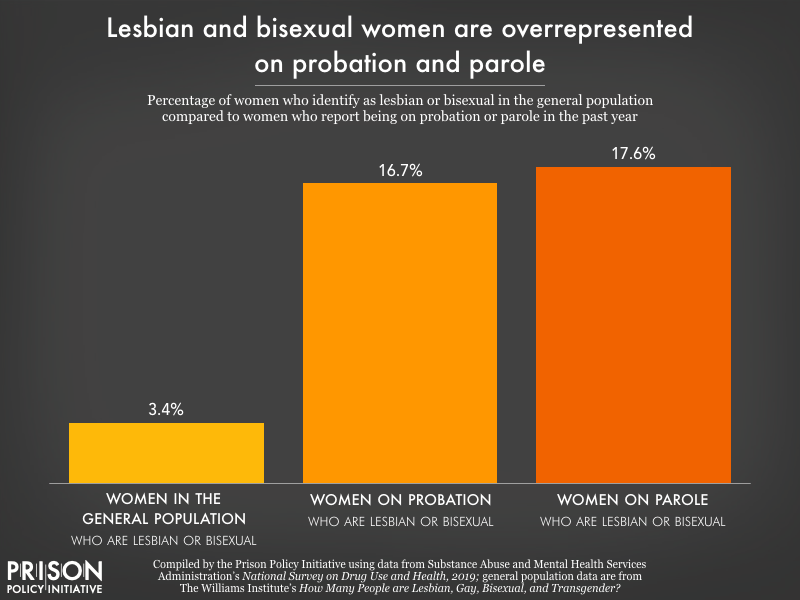Editor’s Note: The Innocent Project of New Orleans has their 21st Anniversary Gala on Saturday, November 19 from 5:30-9:00 PM. The Gala will be held at The Broadside, 600 N Broad Street, and tickets, which you can purchase here, cost $75. You can join IPNO clients and supporters for a special evening with food, open bar, music, a silent auction, and more. To let you know what you’ll be supporting by attending the Gala, we are dedicating this week to work the IPNO does in New Orleans as well as all of the work that needs to be done and makes the IPNO integral to our city.
 Lesbian and bisexual women have one of the highest prison incarceration rates. Unlike in the female prison system, sex is a source of violence in the male jail system, where it is used to emulate authority amongst other inmates. According to ABC news it states “Unlike in male prisons where sex is used as a tool of violence and intimidation, inmates and guards say the sex in female prisons tends not to be coercive. Instead, a lot of the violence [in Metro] is about jealousy or possessiveness.” Lesbian and bisexual women behave differently than most inmates, and they have a higher rate of incarceration than everyone else in the prison system.
Lesbian and bisexual women have one of the highest prison incarceration rates. Unlike in the female prison system, sex is a source of violence in the male jail system, where it is used to emulate authority amongst other inmates. According to ABC news it states “Unlike in male prisons where sex is used as a tool of violence and intimidation, inmates and guards say the sex in female prisons tends not to be coercive. Instead, a lot of the violence [in Metro] is about jealousy or possessiveness.” Lesbian and bisexual women behave differently than most inmates, and they have a higher rate of incarceration than everyone else in the prison system.
It doesn’t get any lighter when research gay and bisexual men in the prison system. They experience prejudice because of their gender identity and masculinity. According to The Conversation conclusion, writers emphasize that “The single-sex environment of prisons creates especially constricted views of gender roles, with a culture of hyper-masculinity dominating male prisons. Hierarchies of masculinity are often enforced through violence.”
In such an environment, any difference is seen as a weakness.
In their most extreme forms, this can include intimidation and physical and sexual violence. As one of the prisoners we interviewed said, “People in here will prey on your weakness, they will prey on you. If you’re gay or bisexual, they’ll use that. They think that you are, as they say…a poof, and you can’t handle yourself. And they try to prey on you.”

In fact, The Williams Institute’s research team found that “LGBTQ individuals receive longer sentences than heterosexual individuals, with lesbian or bisexual women and gay or bisexual men 4.6 and 2.7 times more likely than heterosexual women and men to receive prison terms exceeding 20 years, respectively. Additionally, sexual minorities were more likely to have spent time in disciplinary or administrative segregation or solitary confinement while incarcerated—26.8 percent of gay and bisexual men as compared with 18.2 percent of straight men and 37.2 percent of lesbians and bisexual women as compared with 12.7 percent of straight women experienced solitary confinement while incarcerated. And compared with straight inmates, sexual minorities are more likely to be sexually victimized while incarcerated—17.5 percent of gay and bisexual men and 13.1 percent of lesbians and bisexual women have been sexually assaulted by another inmate or staff as compared with 2.6 percent and 5.7 percent of straight men and women, respectively.”
In the United States, lesbian, gay, bisexual, and transgender (LGBTQ+) community prisoners endure a disproportionately high rate of sexual violence and receive little or no protection from the system. As a form of dominance, other convicts use rape, beatings, and picking on one another. We hope that by reading this article, readers can gain a better understanding of the lesbian, gay, bisexual, transgender, and queer (LGBTQ+) community. Please watch the movie below for a visual portrayal of the daily struggles that the lgtbq+ community faces in prison.
 NOLAbeings
Multimedia artist Claire Bangser created NOLAbeings as a portrait-based story project that marries...
NOLAbeings
Multimedia artist Claire Bangser created NOLAbeings as a portrait-based story project that marries...
 Data corner: Adobe Suite (create a PDF, social media graphic, presentation, edit a photo and video
Data corner is where you go to work with analytics and top tech skills. It takes on everything from PERL and SQL to Canva and Sprout Social.
Data corner: Adobe Suite (create a PDF, social media graphic, presentation, edit a photo and video
Data corner is where you go to work with analytics and top tech skills. It takes on everything from PERL and SQL to Canva and Sprout Social.
